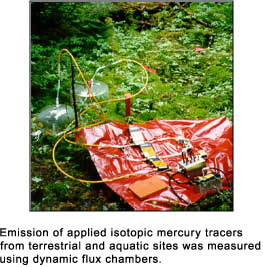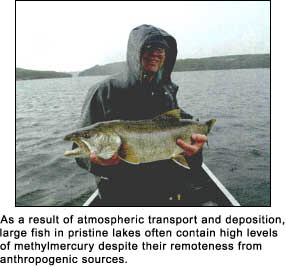Mercury Experiment to Assess Atmospheric Loadings in Canada
and the United States (METAALICUS)
The accumulation of methylmercury in fish is a global contamination problem, resulting in part from the atmospheric transport of gaseous mercury and subsequent deposition to vegetation and in rainfall. Control strategies focus on reducing the emissions of mercury to the atmosphere, but the short term value of that approach may be limited by the environmental cycling of the large inventory of mercury that has accumulated in the biosphere as a result of human activities. A better understanding of processes that regulate the cycling and bioaccumulation of mercury in aquatic systems is needed to know whether reductions in atmospheric emissions will have a near term benefit in constraining the mercury bioaccumulation process and enhancing the value of impacted aquatic resources.


Since 1998, ORNL ESD has participated in the METAALICUS project, a study in which uniquely labeled isotopic tracers of mercury are added separately to the upland, wetland and lake surface of a whole watershed. The ORNL segment of the study focused on air-surface exchange processes, in which a portion of the applied Hg spike is reduced to gaseous mercury and returned to the atmosphere. Our research found that mercury sprayed onto vegetation and soil as simulated rainfall was rapidly sequestered, with little return to the atmosphere after 2 -3 days. Overall, 5 - 10 % of the applied spike was recycled to the air over the course of the year. A portion of the mercury applied to the lake was converted to dissolved gaseous mercury by the action of sunlight, and subsequently returned to the atmosphere. The rate of evasion was highly influence by wind-driven mixing of the water, but also was enhanced by sunny, calm conditions. Overall, ~ 40% of the applied Hg spike was recycled to the atmosphere over each summer/fall study period. Results of these experiments indicate that the cycling mercury in shallow lakes is highly dynamic, suggesting that lakes which receive the bulk of their mercury inputs from atmospheric sources will be highly responsive to changes in loading. The dynamics of mercury in terrestrial system appear to be much slower, and aquatic systems receiving most of their mercury loading from the surrounding watershed may be much less responsive to decreased atmospheric inputs.
Sponsors
U.S. Department of Energy, Electric Power Research Institute.
For more information, contact:
George Southworth (southworthgr@ornl.gov, 865-574-7240)
Revised: 8/24/05
|


